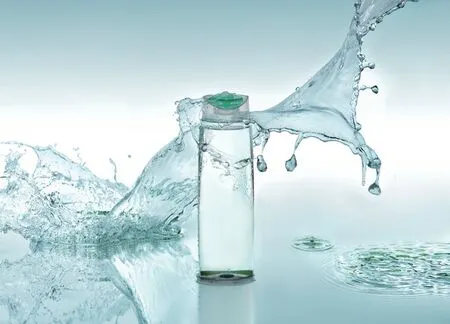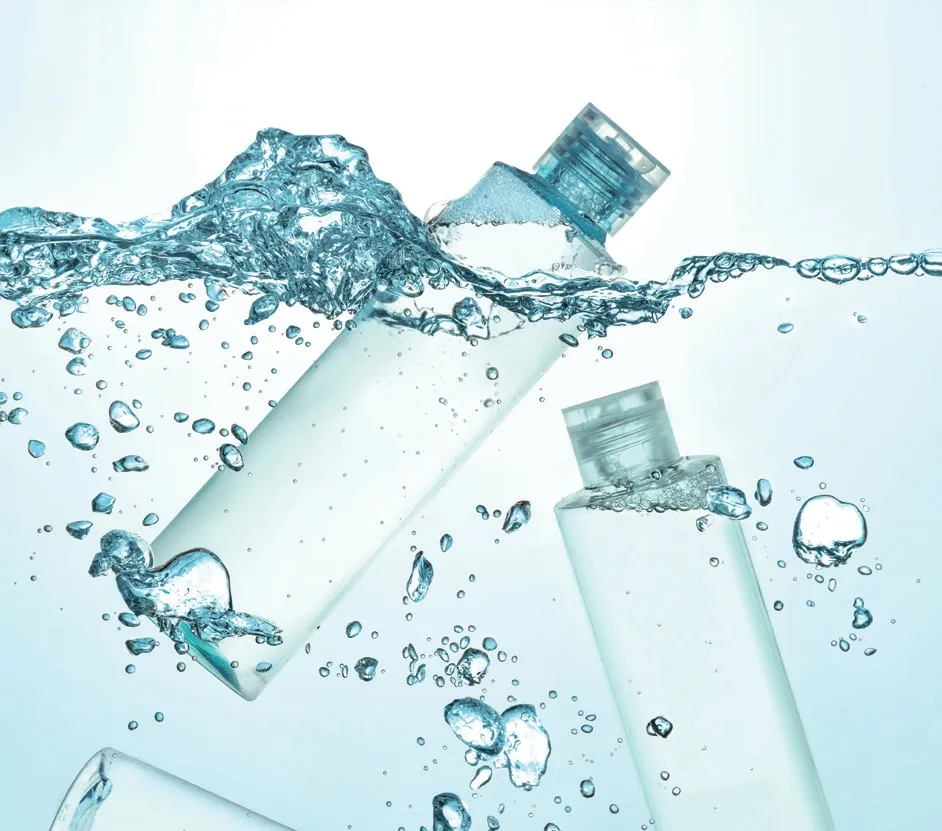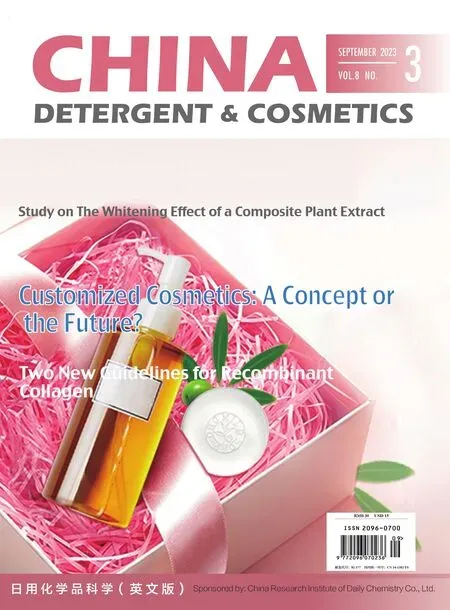Advances in the Study of Chemical Composition and Biological Activities of Aloe Vera Flowers
Yan Yongtao
Perfect Life Sciences Research Institute Co.,Ltd.,China;
Yan Yongtao,Li Xiaomin,Yu Xiaoyi
Perfect (Guangdong) Commodity Co.,Ltd.,China
Abstract This review summarizes the main chemical composition of Aloe vera flowers and introduces their antioxidant,anti-aging,skin whitening,skin moisturizing,anti-skin irritation,and anti-skin allergy effects.Suggestions for the application of Aloe v.flowers in cosmetics are provided.
Key words Aloe vera flower;Chemical composition;Biological activity;Cosmetics
Aloe vera is a perennial evergreen herbaceous plant of the Liliaceae family,with large and thick leaves,mainly growing in tropical and subtropical regions.Aloe v.has antioxidant and anti-skin aging effects and is widely used in cosmetics and other fields[1].
According to the “Flora of China,” Aloe v.flowers have a peduncle height of 60~90 cm,unbranched or sometimes slightly branched,raceme with dozens of flowers,bracteoles nearly lanceolate,apex acute,flowers drooping,sparsely arranged,pale yellow with red spots,perianth about 2.5 cm long,tepals slightly curved at the apex,stamens nearly equal in length or slightly longer than the perianth,and the pistil prominently protruding from the perianth.Aloe v.flowers are edible;they can also be used in medicine,with effects such as cough relief,cooling blood,and resolving blood stasis.This article summarizes the chemical substances and biological activities of Aloe v.flowers,providing a more comprehensive understanding of the plant and promoting the development of Aloe v.flower-related industries.
1 Chemical composition of Aloe v.flowers
According to the characteristics of different developm ental stages of Aloe v.flowers,they can be divided into three stages: Stage I (immature),Stage II (mature,but flower buds are still closed),and Stage III (mature,flower buds open);the chemical composition of Aloe v.flowers at different stages varies to some extent[2].Aloe v.flowers contain amino acids,proteins,carbohydrates,organic acids,fatty acids,volatile substances,carotenoids,vitamins,phenolic substances,and adenosine phosphates.
1.1 Amino acids and proteins
Aloe v.flowers contain glutamic acid,aspartic acid,alanine,phenylalanine,aminobutyric acid,serine,tyrosine,valine,isoleucine,leucine,threonine,glycine,histidine,arginine,proline,lysine,methionine,cysteine,and tryptophan,with glutamic acid being the most abundant.The content of aspartic acid,phenylalanine,and tyrosine varies greatly in Aloe v.flowers at different maturity stages,while the content of other amino acids is not affected by the maturity of Aloe v.flowers[2,3].Aloe v.flowers contain about 1.6% crude protein,some of which exists in the form of bioenzymes.The pollen of Aloe v.flowers contains glutamate transaminase,alanine transaminase,β-hydroxybutyrate dehydrogenase,and lactate dehydrogenase,and the enzyme content in the pollen of Aloe v.flowers from different regions also varies.The amino acids and proteins present in Aloe v.flowers have nutritional and cosmetic values and have moisturizing and softening effects on the skin.
1.2 Carbohydrates
The main carbohydrates in Aloe v.flowers are glucose,fructose,sucrose,galactose,and mannose,and they also contain small amounts of trehalose,xylose,and rhamnose.The content of monosaccharides and trehalose increases with the development of Aloe v.flowers,while the sucrose content decreases with increasing maturity of Aloe v.flowers.In Aloe v.flowers at maturity stages I and II,the content of acetylated polysaccharides is relatively high,while the content at maturity stage III is relatively low[2,4].
Aloe v.flowers’ polysaccharides are mainly composed of acidic polysaccharides[4].Feng Yongmei et al.used hot water extraction,ethanol precipitation,Sevage protein removal,and organic solvent dehydration to extract polysaccharides from Cape Aloe v.flowers and Curacao Aloe v.flowers,and the results showed that the proportion of weakly acidic polysaccharides was 87%[5,6].Chang Xiulian et al.reported the extraction of Aloe v.flower polysaccharides by ultrasonic method,and by studying the effects of temperature,time,water addition,and Aloe v.flower particle size on the extraction of Aloe v.flower polysaccharides,the optimal process conditions were determined to be a temperature of 70 °C,a time of 2 h,Aloe v.flower particle size of 40~60 mesh,and water addition of 150 times the weight of Aloe v.flowers,with an average of 2 water additions.Under the optimal process conditions,the extraction rate of Aloe v.flower polysaccharides was 41.175 mg/g.[7]
1.3 Organic acids and fatty acids
Aloe v.flowers contain citric acid,malic acid,acetic acid,formic acid,and fumaric acid,with citric acid and malic acid being the most abundant.Citric acid content decreases with the development of Aloe v.flowers[2].
Aloe v.flowers contain saturated fatty acids such as octanoic acid,decanoic acid,lauric acid,myristic acid,palmitic acid,stearic acid,arachidic acid,and lignoceric acid,with palmitic acid,stearic acid,and octanoic acid being the most abundant.They also contain unsaturated fatty acids such as oleic acid,elaidic acid,linoleic acid,α-linolenic acid,and 11-eicosene acid,with linoleic acid and α-linolenic acid being the most abundant.Stage III Aloe v.flowers contain the least amount of fatty acids.The types and contents of fatty acids in Aloe v.flowers largely depend on factors such as the species of Aloe v.flowers,geographical region,and climatic conditions.
1.4 Volatile substances
Volatile substances in Aloe v.flowers include benzyl alcohol,1-nonanal,lauric acid,2-hexenal,hexanoic acid,benzaldehyde,methyl laurate,octanoic acid,1-pentanal,butanoic acid,acetophenone,benzyl acetate,and methyl decanoate.These volatile substances contribute to the antibacterial properties of Aloe v.flower extracts[2].Volatile characteristics may be influenced by different metabolic pathways.Generally,floral volatiles are used to attract insects for pollination,so the types and contents of volatiles vary with flower age,pollination status,endogenous rhythms,and environmental conditions.
After drying fresh Curacao Aloe v.flowers at 25 °C,the volatile substances of Curacao Aloe v.flowers were extracted by distillation-extraction and simultaneous distillation-extraction methods,and the contents of Aloe v.flower volatile oils obtained by the two methods were 0.85% and 2.81%[8],respectively.In dry Aloe v.flowers,10 volatile compounds were detected,including 47.92% oxygenated hydrocarbons,29.59% alcohols,1.35% ketones,3.97% terpenes,and 4.89% alkanes.In fresh Aloe v.flowers,24 volatile compounds were detected,including 29.43% oxygenated hydrocarbons,6.82%alcohols,7.28% ketones,and 48.74% terpenes.These volatile substances determine the aroma of Aloe v.flowers and also affect their antioxidant and other biological activities.

1.5 Carotenoids
Aloe v.flowers contain carotenoids such as α-carotene,β-carotene,β-cryptoxanthin,zeaxanthin,and lycopene,with lycopene being the least abundant.Sotelo A et al.found that the carotenoid content in dried Aloe v.flowers ranged from 4.39 to 15.55 mg/100 g[2].Aloe v.flowers can be considered one of the important sources of carotenoids.Carotenoids are effective antioxidants that can modulate the pathogenesis of some chronic degenerative diseases.Consuming Aloe v.flowers can help to reduce health problems caused by vitamin A deficiency.Carotenoids have anti-tumor,antidiabetic,anti-inflammatory,weight loss,antioxidant,and beauty effects;in cosmetics,carotenoids help to prevent the formation of free radicals,reduce skin aging caused by free radicals,and can be used in the development of skincare products[9].
1.6 Vitamins
Aloe v.flowers are rich in vitamin C,with a content 3 to 6 times higher than that of Aloe v.gel.[10]The vitamin C content decreases with the development of Aloe v.flowers.The vitamin C content in stage I fresh Aloe v.flowers is 48.52±3.2 mg/100 g,in stage II fresh Aloe v.flowers is 26.34±3.73 mg/100g,and in stage III fresh Aloe v.flowers is 22.82±0.9 mg/100 g[2].Vitamin C is a well-known antioxidant,widely used in food,pharmaceuticals,health products,and cosmetics.In cosmetics,vitamin C can whiten,antioxidize,and promote collagen proliferation,making it a common cosmetic ingredient.
Aloe v.flowers also contain α-tocopherol,vitamin B1,and vitamin B2[11,12].
1.7 Phenolic substances
Polyphenols and flavonoid compounds are the main secondary metabolites in plants,protecting plants from ultraviolet damage by absorbing ultraviolet light.Keyhanian S et al[13].reported that Aloe v.flowers contain phenolic acids such as chlorogenic,caffeic,5-P-coumaroylquinic,caffeoylshikimic,5-feruloylquinic,5-P-CIScoumaroylquinic,P-coumaric and ferulic acid as well as luteolin,apigenin,quercetin,kaempferol,isoorientin,isovitexin and their 7-O-glucosides,as well as flavonoid compounds such as luteolin,apigenin,quercetin,kaempferol,isorhamnetin,isovitexin,and their 7-O-glycosides,saponins,and luteolin glycosides.Polyphenol content ranges from 0.73 to 1.01%,while flavonoid content ranges from 0.24 to 0.34%.Aloe emodin and glycosylated chrysazin Aloe v.B have also been identified in Aloe v.flower extracts.López A et al[14].reported that Aloe v.flowers contain phenolic substances such as sinapic acid,quercitrin,kaempferol,apigenin,gallic acid,protocatechuic acid,catechin,vanillic acid,epicatechin,syringic acid,chlorogenic acid,gentisic acid,caffeic acid,coumaric acid,ferulic acid,rutin,and myricetin,with gentisic acid,epicatechin,and quercitrin being the most abundant,confirming that Aloe v.flowers are a natural source of antioxidant compounds.Hou Dongyan et al[15].used the HPLC method to determine the mass fraction of aloin in Aloe v.flowers,with 280.0 μg/g and 72.0 μg/g of aloin in Curacao Aloe v.flowers and Aloe v.arborescens flowers,respectively.Compared with water as the extraction solvent,the contents of flavonoid compounds and phenolic compounds extracted using methanol as the solvent were higher[16].Añibarro-Ortega M et al.[4]reported that Aloe v.flowers do not contain anthraquinone compounds or chromone compounds,but do contain phenolic acid compounds and flavonoid compounds,with eight phenolic compounds present in Aloe v.flowers.Sotelo A et al.found that the phenolic substance content in stage I fresh Aloe v.flowers was 130.24 ± 6.07 mg GAE/100 g,and stage III fresh Aloe v.flowers was 79.95 ± 7.10 mg GAE/100 g[2].Additionally,fresh Aloe v.flowers contain more phenolic substances than dried Aloe v.flowers.Phenolic substances are antioxidants that prevent chronic diseases related to reactive oxygen species by scavenging free radicals.Phenolic substances in Aloe v.flowers have great application value in food,medicine,and cosmetics.
1.8 Adenosine Monophosphate (AMP) and others
Aloe v.flowers contain adenosine monophosphate(AMP) and adenosine derivatives,which are involved in metabolic processes.During the development of Aloe v.flowers,the AMP content gradually decreases,while the adenosine content does not show significant differences,indicating that aging may be closely related to energy levels.In addition,other metabolites such as choline and trigonelline decrease with the development of Aloe v.flowers.Choline is a component of phosphatidylcholine,which is one of the main molecules of the lipid bilayer that forms cell membranes.A higher concentration of choline in immature flowers may be related to more stable and robust cell membranes,while a lower concentration in mature flowers may be due to the degradation of phosphatidylcholine,leading to weakened cell membrane properties.Trigonelline is a metabolic alkaloid of some plants.It has antioxidant,antitumor,hepatorenal protection,anti-fat accumulation,antithrombotic,antibacterial,and other effects[17],and can reduce UVB-induced skin photodamage.
2 Biological activities of Aloe v.flowers
2.1 Antioxidant and free radical scavenging activities
Aloe v.flowers have antioxidant and free radical scavenging effects due to the presence of substances such as carotenoids,vitamin C,and phenolic compounds.The antioxidant capacity of Aloe v.flowers is evaluated through DPPH,ABTS,and FRAP assays,showing a gradual decrease in antioxidant capacity as the flowers mature.[2]Using the DPPH method,the antioxidant capacity of stage I fresh Aloe v.flowers is 179.91 ± 8.16 mg TEAC/100 g.Añibarro-Ortega et al.[7]confirmed the antioxidant capacity of Aloe v.flower extracts through an in vitro determination of oxidative hemolysis inhibition,thiobarbituric acid reactive substance formation inhibition,and β-carotene bleaching inhibition.Siahpoosh A et al.[16]confirmed that Aloe v.flower extracts can inhibit hydroxyl free radicals.Wan Jiaqing et al.[18]reported on the antioxidant efficacy of Curacao Aloe v.flower extracts in a zebrafish model,using lipopolysaccharide as the exposure condition and testing the reactive oxygen species (ROS) content in zebrafish.The results showed that 0.2% and 0.4%Curacao Aloe v.flower extracts can reduce the ROS content in zebrafish,confirming the antioxidant efficacy of Curacao Aloe v.flower extracts.Hou Dongyan et al.used the pyrogallol autoxidation method to determine antioxidant activity,with Curacao Aloe v.flowers showing greater antioxidant effects than Aloe v.arborescens flowers[15].Aloe v.flowers can serve as a natural source of antioxidants.

2.2 Tyrosinase inhibition and skin whitening effects
Inhibition of tyrosinase activity can contribute to skin whitening and resistance to pigmentation[7].Flavonoid compounds in Aloe v.flowers can inhibit the activity of tyrosinase.He Linyan et al.[19]reported on the whitening efficacy of Curacao Aloe v.flower extracts in a 3D skin model,using kojic acid as a positive control and UVB as the exposure condition.The apparent color difference,L value,and melanin content of the melanin model were tested.The results showed that the apparent color of the model treated with Curacao Aloe v.flower extracts became whiter,the L value significantly increased,and the melanin content significantly decreased,confirming the skin whitening effects of Curacao Aloe v.flower extracts.
2.3 Skin moisturizing effects
Skin hydration is crucial for maintaining the flexibility and viscoelasticity of the epidermis.Lack of skin moisture can lead to dryness,dermatitis,and various skin problems.Aloe v.flowers are extracted with water,100% ethanol,and 50% ethanol,and the water extract of Aloe v.flowers shows the highest moisturizing effect under both normal and UVB irradiation conditions.The water extract of Aloe v.flowers contains isoorientin[20];when human epidermal keratinocytes (HaCaT cells) are treated with the water extract of Aloe v.flowers or isoorientin,the water extract or isoorientin can upregulate the differentiation marker involucrin (IVL),activate protein kinase C,p38,and ERK 1/2 expression,regulate filaggrin,increase aquaporin AQP3 expression,and promote hyaluronic acid synthesis by regulating hyaluronan synthase 1 and HYAL1 protein[20].The water extract of Aloe v.flowers can protect against UVB-induced skin photodamage and restore skin hydration to normal levels.
2.4 Anti-aging
Increased expression of matrix metalloproteinase-1(MMP-1) and matrix metalloproteinase-3 (MMP-3)leads to collagen fiber rupture and the appearance of aging characteristics such as wrinkles in the skin[21].Autophagy can maintain cellular homeostasis under different stress conditions by removing aged organelles and proteins,regulating keratinocytes,fibroblasts,and melanocytes’ color,homeostasis,and function under external and internal stress conditions,and delaying skin aging[22].Caspase-3 is the main terminal protease in the process of apoptosis,and its activation may lead to genetic instability and play a key role in tumor formation after gene damage[23].The water extract of Aloe v.flowers contains isoorientin,which can increase cell viability,inhibit MMP1 and MMP3 expression,inhibit oxidative stress,and induce autophagy to protect human dermal fibroblasts from UVB radiation;isoorientin reduces Caspase-3 activity to decrease UVB-induced cell apoptosis[24].
2.5 Anti-skin irritation and anti-skin allergy
Sodium lauryl sulfate,a common anionic surfactant,increases intracellular calcium ion influx by interacting with the cell membrane of keratinocytes,stimulating IL-1α secretion and increasing ROS production,causing skin irritation,itching,inflammation,and other adverse reactions[25].He Linyan et al[26].reported on the anti-skin allergy efficacy of Curacao Aloe v.flower extracts in a 3D skin model,using dexamethasone as a positive control and sodium lauryl sulfate as the exposure condition.The concentration of Curacao Aloe v.flowers used was 5%,and the tissue viability,tissue morphology,and inflammation factors IL-1α and TNF-α were tested.The results showed that 5%Curacao Aloe v.flower extracts can enhance tissue viability,improve tissue morphology,and reduce inflammation factor IL-1α,confirming the anti-skin allergy efficacy of Curacao Aloe v.flower extracts.

Compound 48/80 promotes histamine release and causes skin discomfort such as itching;mast cell tryptase (Tryptase) may cause skin itching by activating the PAR-2 receptor.Wan Jiaqing[27]et al.reported on the anti-skin allergy efficacy of Curacao Aloe v.flower extracts in a zebrafish model,using sodium cromoglycate as a positive control and Compound 48/80 as a model control group.The inhibition rate of Curacao Aloe v.flower extracts on zebrafish Tryptase secretion was tested,and the results showed that Curacao Aloe v.flower extracts at volume fractions of 0.1%,0.2%,and 0.4% can significantly inhibit the secretion of Tryptase stimulated by Compound 48/80,confirming the anti-skin allergy efficacy of Curacao Aloe v.flower extracts.
3 Suggestions for the application of aloe v.flowers in cosmetics
Aloe v.flowers have various biological activities and can be applied in health food,cosmetics,and other industries,with a broad application prospect in cosmetics.To better utilize Aloe v.flowers in cosmetics,the following work is recommended.
Currently,commercially available Aloe v.flower extracts are generally brown to light brown,clear to slightly precipitated liquids.When added in large amounts,they may affect the appearance of cosmetics.It is recommended that cosmetic raw material manufacturers develop lighter-colored Aloe v.flower extracts.
Research the extraction and purification methods of Aloe v.flowers,and develop extracts with higher active ingredient content.To facilitate quality control of the extracts,add test items for the content of certain compound monomers or classes of compounds in their specifications.Industry associations or manufacturers can evaluate the feasibility and necessity of establishing group standards or industry standards for Aloe v.flower extracts.
At present,most studies on the efficacy of Aloe v.flower extracts use chemical platforms,cell platforms,3D skin models,zebrafish models,etc.,with few using human subjects for cosmetic efficacy testing.It is recommended to use human subjects to test the soothing effects of Aloe v.flower extracts.Research on the skin-whitening mechanism of Aloe v.flower extracts is also recommended,as well as exploring their anti-wrinkle,firming,repairing,and other anti-aging related effects.Under the guidance of traditional Chinese medicine theory,it is suggested to investigate the synergistic enhancement of Aloe v.flower extracts and other traditional Chinese herbal plant extracts in whitening,soothing,anti-wrinkle,firming,and repairing effects.

